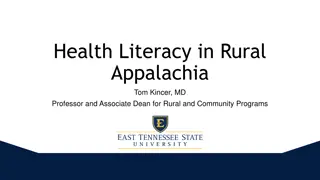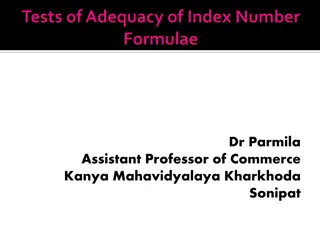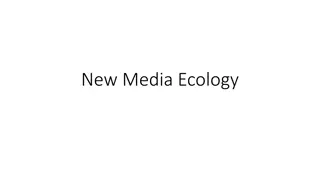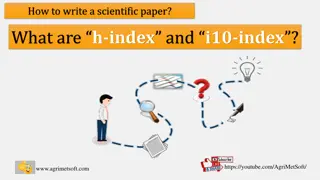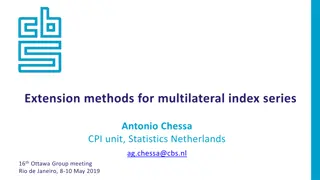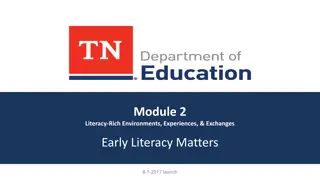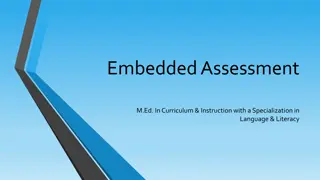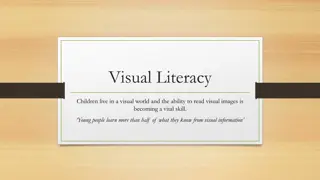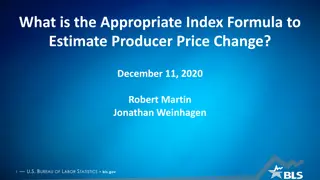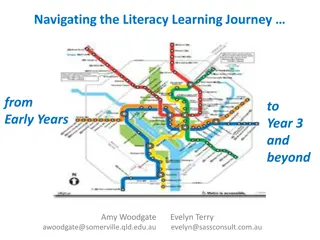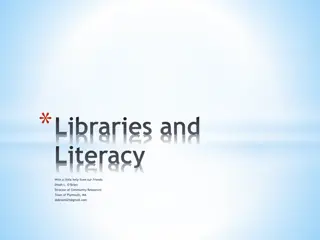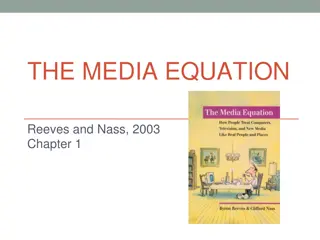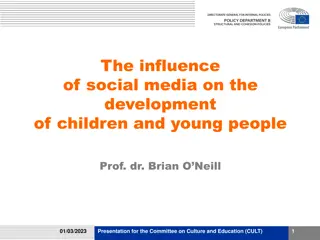Media Literacy Index 2023 Main Findings
The Media Literacy Index 2023 assesses European countries' resilience to fake news and post-truth through media freedom, education, and trust indicators. The index ranks countries based on media literacy scores and clusters them accordingly. Finland, Denmark, and Norway top the list, while countries like Georgia and Kosovo rank lower. The methodology includes indicators such as freedom of the press, education levels, and trust in others. Explore the rankings and understand the importance of media literacy in countering disinformation.
Download Presentation

Please find below an Image/Link to download the presentation.
The content on the website is provided AS IS for your information and personal use only. It may not be sold, licensed, or shared on other websites without obtaining consent from the author.If you encounter any issues during the download, it is possible that the publisher has removed the file from their server.
You are allowed to download the files provided on this website for personal or commercial use, subject to the condition that they are used lawfully. All files are the property of their respective owners.
The content on the website is provided AS IS for your information and personal use only. It may not be sold, licensed, or shared on other websites without obtaining consent from the author.
E N D
Presentation Transcript
Media Literacy Index 2023 Main Findings and Possible Implications Marin Lessenski, OSIS The Role of Civil Society in Countering Disinformation and Promoting Media Literacy Sofia, 7-8 June 2023
What is the index? The index is assessing the resilience potential of a number of European countries to the impact of fake news and the post-truth phenomenon by employing media freedom, education and interpersonal trust indicators. Number of countries 35 countries (2017 2021) 41 countries (2022) Expanded 47 countries
The Ingredients of Media Literacy Methodology of the Media Literacy Index Indicators Weight Media Freedom indicators Freedom of the Press score by Freedom House Press Freedom Index by Reporters without Borders Education indicators PISA score in reading literacy (OECD) PISA score in scientific literacy (OECD) PISA score mathematical literacy (OECD) Share of population (%) with university degree (Eurostat) Trust Trust in others (Eurostat) New forms of participation E-participation Index (UN) 20% 20% 30% 5% 5% 5% 10% 5% Table 1. The table shows the methodology of the media literacy index with the groups of indicators, sources and their respective weight (importance). The data are converted into standardized scores (z-scores) from 100 to 0, highest to lowest.
Media Literacy Index 2023 Score (100- 0) Rank (1-41) Country Cluster (1-5) 1 Finland 2 Denmark 3 Norway 4 Estonia 5 Sweden 6 Ireland 7 Switzerland 8 Netherlands 9 Iceland 10 Belgium 11 Germany 12 Portugal 13 UK 14 Austria 15 Czech Republic 16 Spain 17 France 18 Latvia 19 Slovenia 20 Lithuania 21 Luxembourg 22 Poland 23 Slovakia 24 Italy 25 Croatia 26 Malta 27 Hungary 28 Cyprus 29 Greece 30 Ukraine 31 Serbia 32 Moldova 33 Montenegro 34 Romania 35 Bulgaria 36 Turkey 37 BiH 38 Albania 39 North Macedonia 40 Kosovo 41 Georgia 74 73 72 71 71 70 67 64 62 61 61 60 60 59 58 58 57 55 55 54 53 53 48 47 45 45 41 39 38 38 33 32 32 32 31 29 24 23 22 21 20 1 1 1 1 1 1 1 2 2 2 2 2 2 2 2 2 2 2 2 2 2 2 3 3 3 3 3 3 3 3 4 4 4 4 4 4 5 5 5 5 5 Ranking and clusters
Expanded Media Literacy Index (MLI) 2023 Ranking (1-47) Scores (100- 0) Clusters (1-5) Country 1 Finland 2 Denmark 3 Norway 4 Estonia 5 Sweden 6 Ireland 7 Canada 8 Switzerland 9 Netherlands 10 Australia 11 Iceland 12 Belgium 13 Germany 14 Portugal 15 UK 16 South Korea 17 USA 18 Austria 19 Czech Republic 20 Spain 21 France 22 Japan 23 Latvia 24 Slovenia 25 Lithuania 26 Luxembourg 27 Poland 28 Slovakia 29 Italy 30 Croatia 31 Malta 32 Israel 33 Hungary 34 Cyprus 35 Greece 36 Ukraine 37 Serbia 38 Moldova 39 Montenegro 40 Romania 41 Bulgaria 42 Turkey 43 BiH 44 Albania 45 North Macedonia 46 Kosovo 47 Georgia 74 73 72 71 71 70 68 67 64 63 62 61 61 60 60 60 60 59 58 58 57 57 55 55 54 53 53 48 47 45 45 42 41 39 38 38 33 32 32 32 31 29 24 23 22 21 20 1 1 1 1 1 1 1 1 2 2 2 2 2 2 2 2 2 2 2 2 2 2 2 2 2 2 2 3 3 3 3 3 3 3 3 3 4 4 4 4 4 4 5 5 5 5 5 Expanded Media Literacy Index
Expanded Media Literacy Index 2023: Media Freedom Ranking Media Freedom Ranking Media Freedom Score Overall Ranking Overall Score 2023 Country Cluster Media Freedom Ranking in MLI 2023 1 2 3 4 5 6 7 8 9 32.6 Norway 30.8 Denmark 30.4 Sweden 30 Finland 29.2 Estonia 28.4 Ireland 28.2 Portugal 27.8 Switzerland 27.2 Iceland 26.8 Belgium 26.6 Netherlands 26.4 Luxembourg 26.2 Canada 26.2 Lithuania 25.8 Germany 25 Czech Republic 23.4 Austria 23.2 UK 23.2 Latvia 23 France 23 Slovakia 22.4 Australia 22 Spain 21.8 USA 20.2 Slovenia 19.4 Cyprus 18.8 South Korea 18.2 Italy 17.8 Japan 17.8 Malta 16.4 Croatia 16.4 Poland 16.4 Romania 14.6 Israel 14.4 Montenegro 13.8 Moldova 13.6 Kosovo 12.2 BiH 12.2 Bulgaria 12 Hungary 11.2 Serbia 10.4 Greece 10.2 Georgia 9.8 North Macedonia 9 Albania 8.2 Ukraine 0 Turkey 3 2 5 1 4 6 72 73 71 74 71 70 60 67 62 61 64 53 68 54 61 58 59 60 55 57 48 63 58 60 55 39 60 47 57 45 45 53 32 42 32 32 21 24 31 41 33 38 20 22 23 38 29 1 1 1 1 1 1 2 1 2 2 2 2 1 2 2 2 2 2 2 2 3 2 2 2 2 3 2 3 2 3 3 2 4 3 4 4 5 5 4 3 4 3 5 5 5 3 4 14 8 11 12 9 26 7 25 13 19 18 15 23 21 28 10 20 17 24 34 16 29 22 31 30 27 40 32 39 38 46 43 41 33 37 35 47 45 44 36 42 10 11 12 13 14 15 16 17 18 19 20 21 22 23 24 25 26 27 28 29 30 31 32 33 34 35 36 37 38 39 40 41 42 43 44 45 46 47
Who is afraid of fake news? Global Survey risk perception often doesn t reflect the actual risk of encountering misinformation surprisingly low levels of concern about misinformation in some regions, such as parts of Central Asia and Eastern Europe, where the freedom of the press is in part curtailed. Eastern Europe- 42.7% Central Asia- 38.1% Northern/Western Europe - 61.4%
EU News & Media Survey 2022 Most used media to access news: 75% - TV 43% - online news platforms 39% - radio 26% - social media platforms 21% - print press In Finland, 73% of respondents trust public TV and radio stations, while this is true only for 22% of respondents in Hungary and 23% in Poland. In Luxembourg, 63% of respondents trust the written press, but only 18%of those in Bulgaria and Poland trust the written press.
Implications and recommendations Education and regulation Education before regulation But education is the long road Regulation tough choices Dilemma: disinformation is eroding democracy but regulations can stifle freedom of expression Three sides with roles and responsibilities Traditional Media Online social networks Institutions Consider country and regional differences In some cases the disinformation and misinformation comes from traditional media and/or institutions and online social networks are free outlets Debating the role of CSOs CSOs as media? Or watch dog and advocacy role (e.g. making institutions do their job) CSOs and active citizens Upholding values - democratic values, civic education Partnering with traditional media for teaching media literacy
Interview from Finland: The first line of defense is the kindergarten teacher.





